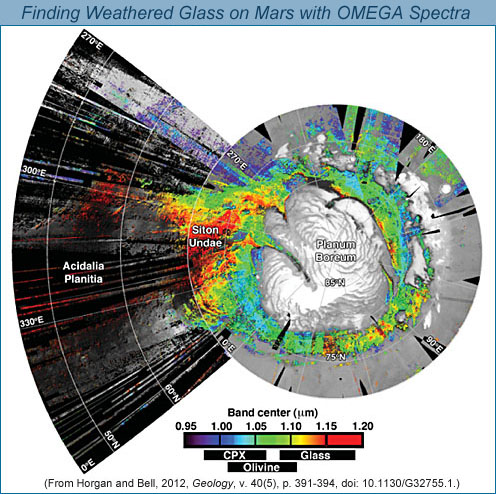Quick Views of Big Advances
Weathered Glass on Mars
Glass-rich sediments in the northern lowlands of Mars have gained more attention lately because of the implications for widespread explosive volcanism and late-stage surface alteration by water. |
Map of the Martian north polar region derived from OMEGA spectra by Briony Horgan and Jim Bell of ASU. The deposits of interest, the iron-bearing glass, appear in yellows and reds. Blues and greens are interpreted as the minerals clinopyroxene or olivine. |
Appearing conspicuously dark in visible light (because of their low albedo) these lowland deposits have been identified in most of the north polar sand sea, in Acidalia Planitia, and in Utopia Planitia. Yet, unlike other low-albedo areas on the planet, most of the northern lowlands have not been interpreted as typical Martian basalt. What set these areas apart in previous studies were mid-infrared spectral signatures of some kind of poorly crystalline, high-silica phase. These signatures were variously explained as volcanic glass (e.g. obsidian) or secondary alteration products such as opal or silica coatings.
Horgan and Bell looked at the northern lowlands in a different light with data from the OMEGA spectrometer on the European Space Agency's Mars Express spacecraft. OMEGA operates in the visible and infrared regions to produce mineralogical maps of the Martian surface. Based on their analyses of OMEGA data plus comparisons with rover and other orbital data, lab studies, and terrestrial analogs, Horgan and Bell conclude the low-albedo sediments are 80-90% glass, likely composed of sand-size grains of iron-bearing glass. A glass so durable it even forms dunes. They propose the glass was created during explosive volcanic eruptions when lava violently interacted with ice and water, in contrast to eruptions that poured out sheets of lava. Given the vast extent of these glass-rich sediments, explosive volcanism may represent more of a global process than previously thought. And, teasing out even more subtle details from the OMEGA spectra, the researchers suggest the glass grains are glazed with silica-rich rinds that they interpret as a post-depositional alteration feature due to acidic leaching by fluids derived from ice or snow melt. The idea of such widespread, chemical weathering of iron-rich glassy deposits in the relatively-young (Amazonian-aged) northern lowlands is very intriguing and will generate further investigations of the volcanic and climate history of Mars.
![]() (pdf version)
(pdf version)
See: Horgan, B. and Bell III, J. F. (2012) Widespread Weathered Glass on the Surface of Mars, Geology, v. 40(5), p. 391-394, doi: 10.1130/G32755.1 [ article ], and the PSRD article: Timeline of Martian Volcanism. See also information about OMEGA on the Mars Express Mission, from the European Space Agency.
See also the June 2012 "Image of the Month" from the IAG Planetary Geomorphology Working Group: Glass-rich Sand Dunes and Plains Suggest Ice-magma Interactions on Mars, with images and captions by Briony Horgan (Arizona State University).
Written by Linda Martel, Hawai'i Institute of Geophysics and Planetology, for PSRD.
[Wide-screen version of report.]
|
|
[ About PSRD | Archive | CosmoSparks | Search | Subscribe ] [ Glossary | General Resources | Comments | Top of page ] |
